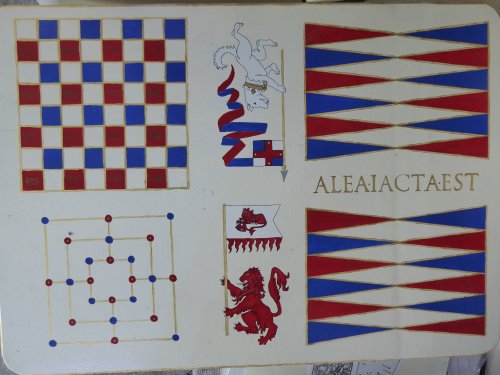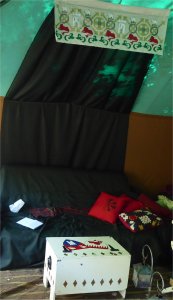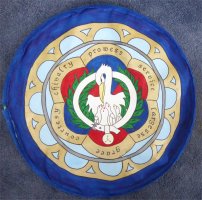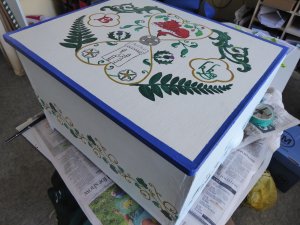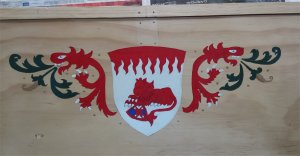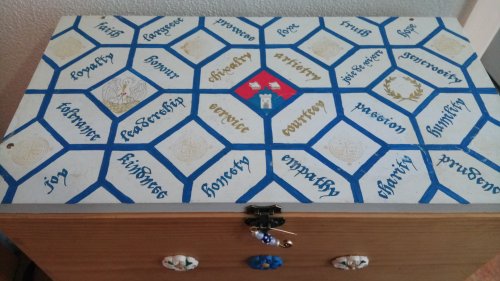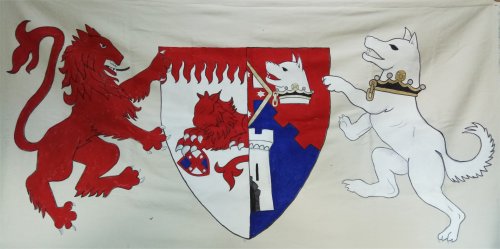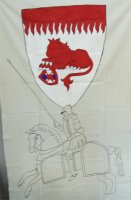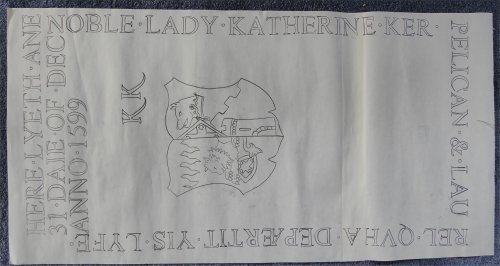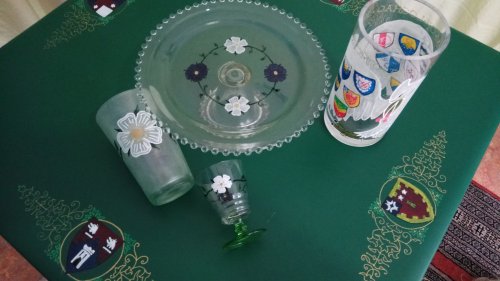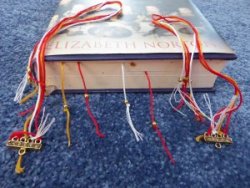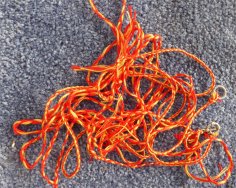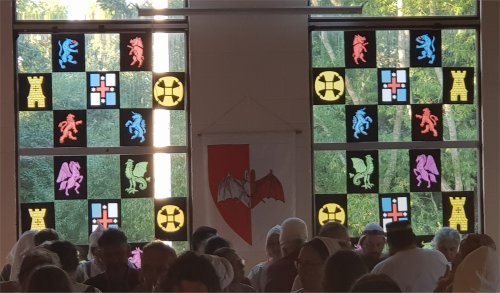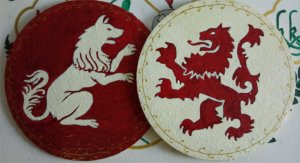 |
|
A&S Challenges: Applied Heraldry
Half-Circle/ Green Man Items: Games Table, Sofa Valence, Royal Valence, Ceiling Boss, Green Man Shelf Unit Other A&S Challenge Topics VPC7: Show Us Your Arms: The Baskin-Kerr Gaming TableI confess to a certain degree of tent envy when I visit people with lovely period pavilions with beautifully painted tables showing all their household’s arms. In an attempt to gussy up the Green Man (my rather mundane tent), I’ve added a number of decorative elements.
One such is a gaming table. There are plenty of examples of gaming boards being painted, carved or simply scratched into surfaces; this one is a TSCA item, rather than having been fully researched and recreated from any specific period examples. It uses my livery colours of red, white and blue, with references to my main heraldic charge of a white, pointy-eared cur, as well as rampant lion supporting Bartholomew’s arms of a lion dormant. The table itself is a spare slab of customboard with edges routed by Bartholomew, resting on a discounted luggage rack from the Warehouse. Half-Circle/Green Man Items: Sofa Valence, Royal Valence, Ceiling BossSofa Valence
I have also painted a valence as part of an attempt to make Bartholomew’s new sofa less obviously mundane. It bears our various charges: lion, tower, cur’s head, as well as the Canterbury cross. I have been collecting various images of things that look like benches (or sofas?) hidden under large swathes of material. There is a miniature in Froissart's Chronicles depicting the Bal des Ardents (the Ball of the Burning Men), an occasion in 1393 where five noble French dancers dressed in foliage as wild men caught fire. What interests me is the shape of the fabric-covered bench the royal ladies are seated on. It really does look like a standard slope-armed sofa, complete with a cushion to lean on at one end. I did start making a large-scale lino print to add some nice printed flowers to my sofa cover, but the textile ink persisted in running off the rather nasty nylon-based cover (what can I say, it was a huge amount of material scavenged from a lost property dump). Another interesting faux sofa can be found in Lorenzetti's 14th-century Allegory of Good and Bad Government, which I saw in Siena's Palazzo Publico. Pax (Peace) is lounging back on a fabric-covered divan, having piled up un-needed armour and thrown a cushion on top of it. The fabric continues across a whole bunch of items, uniting the members of Good Government through soft furnishing. The end of the bench supporting Pax appears to be solid wood with some nice decorative turned elements. One day, I could see a break-down variant being a handy structural agent for our detumescing sofa. In a related Heraldic Challenge project, I made a cloth of estate with a valence for the Royal Box at Half-Circle Theatre -- the Royal Chamberlain had been in distress at the number of ripe plums falling on His Majesty's new garb. As the Faire's theme was to be the Great Hunt, the new valence had an heraldic beast theme, featuring a cur, stag, boar, unicorn and fox.
VPC29: A Bird In The Hand : Pelican Ceiling Boss
As part of the plan to gussy up the Green Man tent, I decided to make a ceiling boss; it would also cover the open hole at the tent pole apex. Neither wood nor stone would be suitable for suspending from my tent; mine was to be a painted boss. The main feature is the Pelican in Her Piety (ie plucking her breast to feed her chicks). This was originally drawn by Lord Ronan mac Briain for a project of mine some years ago, where the pelican was to form a keystone in a painted church wall. But my artistic skills weren’t up to that particular project so it has been in the pending list for some years. The general design of the ceiling boss mirrors that found in church stained glass windows but with SCA symbology of the Pelican, Laurel, Knight and Master of Defense, surrounded by a set of suitable virtues to which I believe one should aspire: service, chivalry, prowess, courtesy, largesse and grace. Its size was chosen to match a spare length of boning that had been lying around for some years, which makes it eminently packable as it folds down to a small size. In a way, I have another ceiling boss to my name. After some judicious heavy hinting, my dear lord bought me sponsorship of the cleaning and conservation of a 16th-century ceiling boss in St George's Chapel Windsor. It's a white dog -- well technically a Henry VII Tudor greyhound (Boss NN6.6), but I no complain. I also have sponsored restoration on a copy of Cicero's collected works (printed in Basel in 1534, C.267), and got to visit it and my dog one delightful afternoon (the Chapel people are lovely and very forgiving of the odd Renaissance fan...). And make sure you go to Evensong while you're there -- you get to sit in the Garter stalls surrounded by more heraldry than you can shake a white baton at (not to mention tons of dead kings and queens -- it's fabulous!). Green Man Shelf UnitI desperately needed some sensible storage solution in the Green Man and, after much sketching and measuring, Bartholomew produced a very handy break-down dresser, with a batch of shelves to fit the various storage boxes I have accumulated. The plywood was a tad jarring, so I stained the thing green and added quatrefoils of symbols of my favoured saints: St Dominic (a white dog), St Barbara (with her white tower), and a top frieze of our heraldic beasts amongst foliage. A piece of green linen with stamped gold quatrefoils covers the lower shelves, nicely hiding the plastic bins, fire extinguisher and defib. Chests: Feast, Lion, Virtue
Bartholomew made me a feast chest to carry around my breakable feast gear – most of it doesn’t get to events as I worry about it not surviving. That has been painted with a version of the favour I made for when Bartholomew used to fight, which has our heraldic elements combined within foliage-bearing gold hearts. The wreath came out a little too silver ferny, but I can live with it.
We commissioned two of Sir Callum's brilliant stacking chests which open from the side -- no more forever rearranging the things on top for when you need to get in! One has been painted with Bartholomew's arms flanked by lion foliage grotesques. I have a lovely brass lion-shaped lock from Iran which closes the catch. The other chest is for my gear. It has three carved roses in blue and white for my persona mother's arms (Mocenigo) and my York descent; these were found in an ancient hardware shop in the back-blocks of a Sicilian village, wish I'd bought more! The top of the box emulates some Spanish floor tiles (a printout is pasted on the inside), each painted block holding one of the virtues espoused at my Laurelling as being the most important for a peer. There are 24 virtues (!) carefully arranged about my arms, a Pelican and a Laurel wreath. A scrapbooking stamp provided a nice gold motif.
Marriage ArmsAnother hanging for the Green Man, depicting the marriage of two houses, the Baskins and the Kerrs.
Arms Hanging
Back in AS44, I had made a batch of large hangings, based on Lady Day tilt artwork, for the combatants in the November Crown Tourney that year. Years later, I came across a pencilled spare at the bottom of my calico heap, so figured it would make a good thing to finish off as decoration and for the baronial heraldic challenge. VPC26: Forget Me Not : Armorial TombstoneThis rather macabre project involved producing a tracing of katherine kerr's tombstone, which is very similar to that of her cousin Ionet Ker (Lady Restalrig). According to the 1927 drawing made by S.T. Calder in Restalrig Church, Janet Kerr died on the 12 Day of Maii Anno 1596. Katherine's tombstone follows the same pattern, but notes that she died on the 31 Daie of Dec 1599 (the last day of the SCA period), cites her as being a Pelican & Laurel, and includes her augmented arms marshalled with those of her husband Master Bartholomew Baskin.
Glassware: Kingdom Humpen, Tazza and othersIt took me some years to get over losing my lovely, but short-lived, Venetian betrothal goblets in the big 2011 earthquake, but I finally have got back into trying my hand at painting on glass, using Vitrea paints and Posca markers with varying degrees of success. I found a remaindered cake stand which was a close match for a 16th-century Italian tazza. It, a beaker and a goblet formed the basis of a set of heraldicly themed glassware based on the Mocenigo arms of my persona mother. The beaker's glass crazed when fired in the oven and a small chip blew out, so it's now used as a hurricane glass for candles. At the right is the Lochac Beaker (see notes below). The glassware sits on a fold-out card table, rescued from my brother-in-law's inorganic rubbish pile and painted on four edges with my arms and those of my lord's, the Barony of Southron Gaard and the Kingdom.
Reichsadlerhumpen: The Imperial Eagle Beaker and Kingdom Humpen I have seen a lot of these shared drinking beakers throughout museums and castles in Europe, and have long wanted to produce one with a Lochac bent. I should really have done this years ago when my eyes were sharper and my hand steadier! The Reichsadlerhumpen, or eagle glass, was a highly decorated large beaker featuring the double-headed eagle of the Holy Roman Empire covered in heraldry and religious and imperial motifs. It was a common subject in print and gained popularity in the 1500s as decoration for the large straight-sided drinking vessel used for shared drinking. The decoration symbolized the Empire’s unity, often with the four different orders of society represented in rows. It was a familiar motif being a common printed subject from the 1500s, such as the Quaternion Eagle of de Negker, printed by David de Negker, based on a 1510 woodcut by Hans Burgkmair (Edwards, pg 74). A Getty commentary notes that “this classification did not correspond to political reality; instead, it presented an idealized image of unity where little existed”. As a shared drinking vessel, these beakers tended to be on the large side, some 30-40 centimetres in height, 10-14 cm in diameter, holding 3-4 litres. The cylindrical glass typically had a small footrim, and the glass itself was green tinted. The green tint was referred to as waldglass, or forest glass (Edwards, pg 73). The artwork usually took the form of around 56 (!) coats of arms of the electors of the Holy Roman Empire, cities, eccelisiastics and estates, laid out on the wings of the crowned and haloed Imperial Eagle. Older versions (or possibly more papist versions) would have a crucifix bisecting the eagles; others had a less-contentious imperial orb (V&A). The beakers often had bands of decorative dots and rosettes or inscriptions such as mottos or even maker attributions circling the rim and base. The enamelling technique came to Germany from Venice, on the part of immigrating craftsmen (though it was actually illegal for such people to leave Venice). The oldest extant example dates from 1571, and is in the British Museum; other examples ranging over the following 20 years are found in the V&A, Rijksmuseum and Getty collection. According to a V&A reference, “the painting of this particular design was used as a compulsory exercise to test the skill of apprentice guild-masters.” The Lochac Beaker As a keen cartographer and period printer, I have seen the Imperial Eagle image over the years and thought about modifying it for some applied heraldry use within the SCA. Having seen a Reichsadlerhumpen in the V&A, I was able to get some good close-up images of it and it formed the inspiration for a Lochac Beaker. The local Mitre 10 hardware store provided a suitable item in the form of a straight-sided vase, for a more modest beaker. Given that I have 12 baronies in the Kingdom to represent, the smaller size seemed appropriate. Instead of the Imperial Eagle, I chose to use the Pelican as a suitable symbol for a unifying feature of our Kingdom, and this in turn inspired the inscription circling the top: In Service to the Kingdom of Lochac. References VPC21: Fly The Colours : Bookmarks and Award Cords in Baronial LiveryFrom the 12C onwards, cords, threads of strips of leather were attached to beads, buttons and similar shapes to make stand-alone bookmarks. Multi-threaded bookmarks were particularly popular amongst the clergy for flipping back and forth in service books. The earliest bookmarks appear to have been the register bookmark, made of cords of vellum, leather or string attached to the headband, knotted at the other end which projected past the text block (example above from Petrus Christus Portrait of a Young Man). Some of them were simply looped through a tab or hole near the top of the spine (Roberts). In other cases, the bookmark is an independent set of cords, ribbons or other markers held in place by the button or bead sitting across the top of the text block.Medieval Clothing and Textiles Vol 3 covers a variety of 12-16C versions (pg 145-179) which include rolled parchment "pippes" or round or flat bars otherwise made out of beads or bone, metal or wood. Some of these were precious metal or inlaid or enamelled. To these would be attached fine cords, threads, strips of leather or ribbons, typically in even numbers ranging from a single pair attached to the anchor, to as many as 14. The ends of the cords would be finished with knots, beads, pearls or tiny tassels. This is the style of my bookmarks, using necklace ends, beads and embroidery cord
I also tried learning a couple of different braiding patterns and made up a batch of award cords in baronial colours, with simple circle-and-bar closures. Beastly WindowsIn ASLIII, the Canterbury Faire theme was Beasts, so I used this to try out a new approach to the Great Hall window decorations. In earlier years I had tried a couple of ways of cutting silhouettes to take the modern edge off, but this never quite worked out. Generally the materials used -- book vinyl and cartridge roll -- were too heavy to remain in place. Declan -- my helpful go-to tall person -- started musing about whether we could make wooden panels and attach them somehow and that sparked an idea. I still had a large amount of black cartridge paper on my roll, and it would make the perfect base for "stained glass" panels, laminating suitable silhouettes covered with coloured cellophane. Make them in roughly A3 size and they would be light enough to stick up and easy to take down. The trick is to use matte laminate and cut to the edges to avoid the tell-tale "frame". So some careful measuring later and I had the general outline for the two sizes of windows. Silhouettes of a range of heraldic beasts were found, and there was much cutting and adapting and laminating. As a final touch, the artistic Lord Ronan mac Briain took away my kinder-art output and, with great attention to detail, returned with panels scribed to look pleasingly like period stained glasswork. The heraldic beast theme worked nicely, as we ended up with the panther and boar of Southron Gaard's founding Baron and Baroness, Eleonora van den Bogaerde and Sigurd Hardrada, and the lion and unicorn of then-BB Richard d'Alliers and Ginevra Visconti. The pegasus and cockatrice reference Lochac's supporters and are the names of the Kingdom's newsletter and A&S publication respectively. A stag and a bull filled the other places, along with panels repeating the Southron Gaard tower, the Canterbury cross and the Lochac arms.
I also bought an arabesque punch (like a hole punch but more complex) and made up a batch of filler rectangles from the spare bits of A3 laminate. which we didn't have to use (I got the window measurements right, yay!). But it does mean that we can use these forms on other windows. The following year I swapped out some of the beast panels for that year's agrarian theme. Thus we had a line of rose, clover leaf, wheat sheaf and grapes to match the spring, summer, autumn, winter seasonal feast, and a sheep fleece. The line honouring the B&Bs had the lion and unicorn, representing Richard and Ginevra as the out-going B&Bs, and a Santiago cross and padlock for the in-coming B&Bs who stepped up at that Faire, Their Excellencies Alexandra de Santiago and Grim of Thornby (a Laurel in locks). The window panels have proved versatile, having been used at other venues to give a nice atmosphere on otherwise mundane windows and glass doors. Placemat Roundels
I've long-admired the wooden roundels used as placemats on Elizabethan tables, and have had a set of cork placemats waiting for when I could get around to making some (or at least improving on my earlier attempts). So the Baronial Heraldic Challenge gave me a push, combined with inspiration from the Canterbury Faire ASLIII beastly theme. I ended up painting six roundels: a lion rampant and unicorn couchant for the B&B; a pegasus and cockatrice for the Crown at the feast High Table; and a red lion and white cur for my lord and me.
| ||||||||||||||||||||||||||||||||||||||||||||||||||||||||||||||||||
